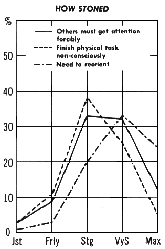
Note.—For guide to interpreting the "How Stoned" graph, see note on Figure 6-1.

 |
| Figure 15-1. INTENSITY OF ABSORPTION IN THOUGHT Note.—For guide to interpreting the "How Stoned" graph, see note on Figure 6-1. |
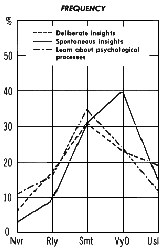 |
| Figure 15-2. INSIGHTS INTO SELF AND OTHERS |
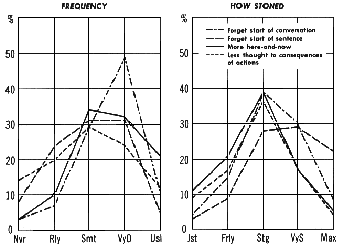 |
| Figure 15-3. HERE-AND-NOW-NESS VS. MEMORY SHORTENING Note.—For guide to interpreting the "How Stoned" graph, see note on Figure 6-1. |
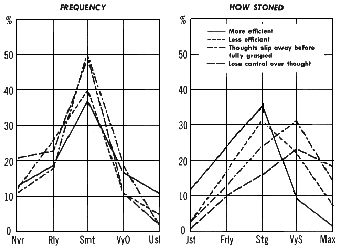 |
| Figure 15-4. EXPERIENCED EFFICIENCY OF THOUGHT PROCESSES Note.—For guide to interpreting the "How Stoned" graph, see note on Figure 6-1. |
 |
| Figure 15-5. EFFICIENCY IN PROBLEM SOLVING: FEELINGS VS. LATER EVALUATION Note.—For guide to interpreting the "How Stoned" graph, see note on Figure 6-1. |
I smoke marijuana once or twice a week for recreation, but a couple of times I've started thinking about my work when stoned and had real breakthroughs as a result. Once, when I had been in the process of setting up a new laboratory for several months, I got stoned one evening and started thinking about things at the lab and suddenly had all these ideas popping into my mind of little things I had to do if the laboratory was to function on schedule, little details about equipment that were unspectacular but essential. I listed about twenty ideas in an hour, and every one of them checked out the next day. They were all sorts of things that had been pushed to the back of my mind by more obvious problems in setting up the laboratory. Another time I got thinking about a problem area in my work, and all sorts of theoretical ideas came popping into my head. They fit together into a coherent theory which looked damned good the next morning—I have since published the theory and organized a lot of research around it, to my great advantage.
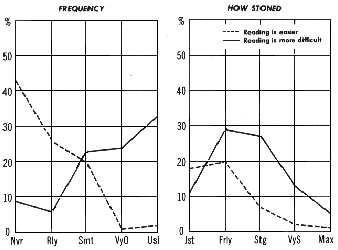 |
| Figure 15-6. EASE OF READING WHILE INTOXICATED Note.—For guide to interpreting the "How Stoned" graph, see note on Figure 6-1. |
| Just | Fairly | Strongly | Very Strongly | Maximum | |||||
| |||||||||
| Prolonged blank periods | |||||||||
| SO ABSORBED IN THOUGHT OR FANTASY THAT NEED TO REORIENT AFTERWARDS | |||||||||
| LOSE CONTROL OF THOUGHT | |||||||||
| BLANK PERIODS | |||||||||
| FORGET START OF SENTENCE | |||||||||
| ABSORBED, ATTENTION MUST BE FORCIBLY GOTTEN | |||||||||
| THOUGHTS SLIP AWAY BEFORE GRASPED | |||||||||
| FORGET START OF CONVERSATION | |||||||||
| FINISH TASK EVEN THOUGH MENTALLY LOST TRACK OF | |||||||||
| MIND FEELS LESS EFFICIENT | |||||||||
| SKIP INTERMEIATE STEPS IN PROBLEM SOLVING | |||||||||
| LESS THOUGHT ABOUT CONSEQUENCES OF ACTIONS | |||||||||
| MORE HERE-AND-NOW | |||||||||
| INSIGHTS INTO OTHERS | |||||||||
| NEW SIGNIFICANCE TO COMMONPLACE CONVERSATIONS | |||||||||
| SPONTANEOUS INSIGHTS INTO SELF | |||||||||
| WORK LESS ACCURATELY | |||||||||
| THOUGHT ACCOMPANIED BY VISUAL IMAGES | |||||||||
| THOUGHT MORE INTUITIVE | |||||||||
| HARDER TO READ | |||||||||
| IDEAS MORE ORIGINAL | |||||||||
| DELIBERATE INSIGHTS INTO SELF | |||||||||
| MIND FEELS MORE EFFICIENT | |||||||||
| APPRECIATE MORE SUBTLE HUMOR | |||||||||
| PLAY ELABORATE GAMES | |||||||||
| WORK MORE ACCURATELY | |||||||||
| MORE VISUAL IMAGERY WHEN READING | |||||||||
| ACCEPT CONTRADICTIONS MORE READILY | |||||||||
| EASIER TO READ?* | |||||||||
| Just | Fairly | Strongly | Very Strongly | Maximum | |||||
| BACKGROUND FACTORS | EFFECTS | |
|---|---|---|
| More Drug Experience | More frequent: More subtle humor Easier to read Recall more of material read More intoxicated for: Absorbed, attention must be gotten forcibly Forget start of conversation | Less frequent: Mind goes blank So absorbed need to reorient afterwards More here-and-now Less thought to consequences of actions Mind feels less efficient Thoughts slip away before grasped Harder to read Less intoxicated for: Spontaneous insights Insights into others Less thought to consequences of actions |
| Older | Less frequent: Absorbed, attention must be gotten forcibly Recall less of material read Less intoxicated for: Prolonged blank periods | |
| More Educated | Less frequent: Absorbed, attention must be gotten forcibly Lose track of task, but finish it anyway Less intoxicated for: Prolonged blank periods | |
| Males | More intoxicated for: Forget start of sentence | Less frequent: Prolonged blank periods Skip intermediate steps in problem solving |
| Meditation | Less frequent: Recall less of material read Less intoxicated for: More here-and-now Think intuitively | |
| Therapy & Growth | More frequent: Recall more of material read | Less frequent: Harder to read Recall less of material read |
Several background variables had non-linear effects. Moderate
Total users were less intoxicated for the experience of finishing
some physical task without realizing it, and they accepted contradictions
between ideas less frequently than the Heavy or Light Total users.
The Weekly users experienced thoughts slipping away before they
could grasp them less frequently than the Occasional or Daily
users.
The effects of greater drug experience form a pattern that suggests
that more experienced drug users: (1) get into psychological,
insightful material at lower levels; (2) have given up the here-and-now-ness
orientation to some extent; and (3) have altered a number of effects
that might be detrimental to long-term adaptation to the world.
With respect to the latter point, the experienced users more frequently
find it easier to read and retain what they read, and less frequently
experience blank periods, thoughts slipping away, decreased planning
(less thought to consequences of actions), and disorientation
from hyper-absorption in thoughts and fantasies; also high absorption
and memory span shortening shift to higher levels of intoxication.
DRCNet Library | Schaffer Library